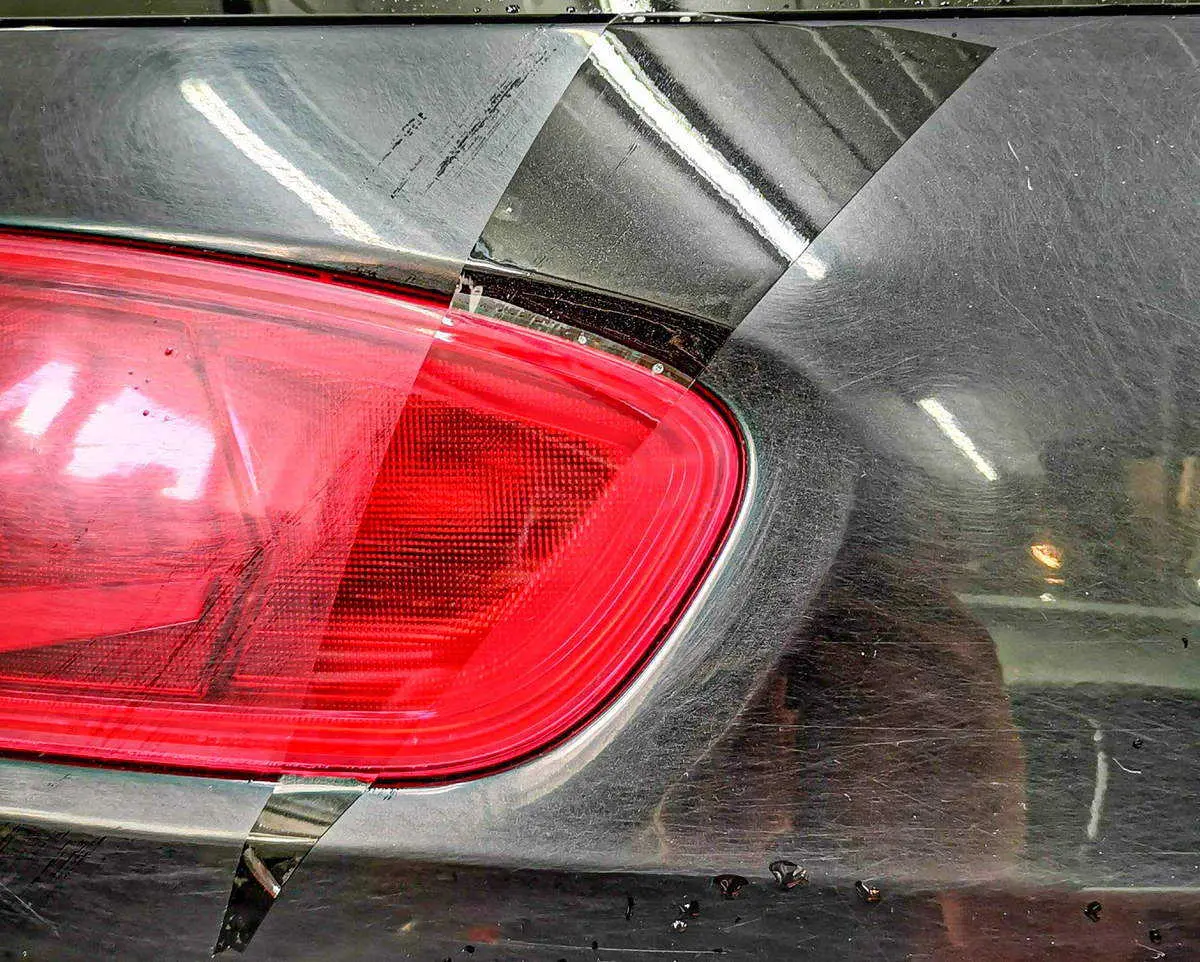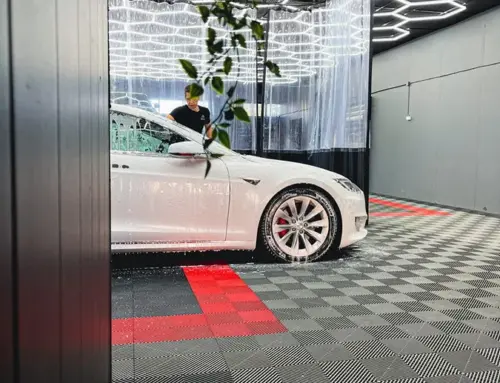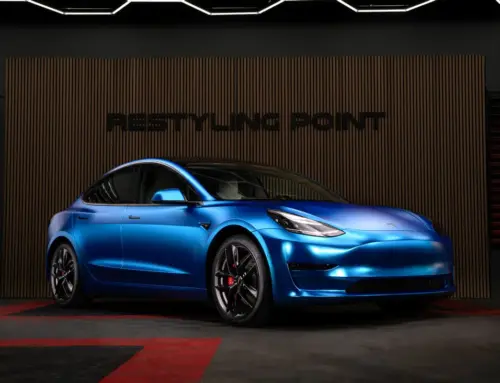How do products differ from each other? Which one withstands stone chips and washes better? Can PPF film be obtained in colored variants? Which one is advisable for a low-mileage vehicle?
Under the magnifying glass, there are two most commonly used, most effective materials that are applied to the surface of car paint for protective purposes.
Vinyl Wrap
Throughout history, cars have been wrapped with traditional colored tapes, also known as vinyl tapes. These have been seen on vehicles used for advertising various businesses. Colored tape is a cast adhesive, typically with a thickness averaging 100 µm (microns). The warranty for the tape ranges from 1 to 10 years, depending on the material manufacturer. Popular high-quality American and French tape manufacturers include:
- Avery Dennison (10-year warranty)
- Orafol (10-year warranty)
- 3M (1-year warranty)
- Hexis (10-year warranty)
- Mactac (5-year warranty)
Inozetek, TeckWrap, KPMF are lesser-known smaller brands that offer some interesting products.
Colored tapes are used for styling purposes on cars for color changes or for detailing such as mirrors, roof, diffusers, chrome parts of the car, interior trims, etc.
Did you buy a boring white car and want to change it to your favorite color? This can easily be achieved through vinyl wrapping.

Don’t like the chrome on your car? Shadowline or Black Edition wrapping is easily achievable and usually more cost-effective than opting for the factory Black Edition package.
Surface options for wraps include:
- Gloss
- Satin
- Matte
- Gloss chrome
- Satin chrome
- Matte chrome
- Carbon fiber pattern
- Brushed aluminum pattern
- Wood grain, leather grain
- Camo pattern
- Printing possibility = only limited by imagination

Advantages of colored wraps:
- Lower cost compared to PPF film
- Moderate resistance to stone chips
- Material’s technical properties enable seamless wrapping of highly curved surfaces, even “one piece”
- Wide selection of colors and patterns
- The wrap withstands machine washes very well, such as GoWash, etc. However, machine washes are at the customer’s own risk and are not covered by warranty terms.
- Quick installation / car delivery process. For example, re-wrapping a damaged part in collision situations is fast
- Coverage of paint surface damage

Weaknesses of colored wraps:
- Stone chips: Moderate resistance to stone chips. Typically, when a stone or nail hits the wrap, a small piece of about 1 x 1 mm may chip off, revealing the paint underneath. The result may not be aesthetically pleasing, especially if the car is white and wrapped in a contrasting color, as the front end may appear patched.
- Fading: The wrap fades in the sun over time. Certain colors fade faster in the sun than others. Regardless of the manufacturer, all dark colors fade slightly in the sun because dark colors absorb the most sunlight and heat up the surface of the wrap, leading to pigment degradation.
- Orange peel texture: The surface smoothness of the wrap may come as a surprise to some and can affect decision-making. Depending on the manufacturer, the wrap may have a lightly orange peel-like texture, meaning it’s not as smooth and mirror-like as paint or PPF. For example, gloss black wrap from Orafol and Hexis tends to have a smoother surface than many others. In 2020, Inozetek introduced a stunning glossy wrap.
For ease of maintenance, it is recommended to apply a ceramic coating over the wrap.
“Before applying the ceramic coating, consider these points.”
PPF (Paint Protection Film)
PPF (Paint Protection Film) is the younger sibling of traditional vinyl wraps, but it came onto the market with more innovative features. PPF is twice as thick as traditional wraps: 200 µm, and in special versions, even triple: 300 µm. Car manufacturers have long used PPF on new cars in sensitive areas prone to stone chips, such as corners of sills and arches. Even Hyundai and Kia have used small pieces of protective film. Porsche has long applied large pieces of PPF at the factory to the lower corner of the rear door.
PPF film was originally produced only in a transparent version. It was initially made as the world’s best transparent protection for those who like the color of their car and only want to protect it for investment purposes in terms of resale value.

n most glossy PPF films, there is already a feature similar to ceramic coating called Topcoat. Water repellency is a consistent benefit of both ceramic coating and Topcoat. With one installation, you get protection against physical damage as well as chemical damage, making it much easier to keep the car clean because it repels water and dirt. However, matte PPF films have not yet succeeded in adding the Topcoat feature, so a ceramic coating is almost mandatory as an accessory on top of matte PPF film.
PPF films have a self-healing surface. The technical term “Self Healing” means that scratches incurred during use disappear due to heat. Any form of heat, such as boiling hot water or a heat gun, is sufficient.
Technically, as the surface warms up, the molecular structure of the film merges, and the scratches disappear in the same way as wounds on our skin. This is a great and invaluable feature, especially on darker cars, where scratches are more visible.
Officially, self-healing feature is not present in vinyl wrap, but it exists in its lightest form and is particularly noticeable in dark wrap colors.
Thanks to its thickness and elasticity, PPF film has repeatedly proven its ability to keep external damage away from the paint surface, such as stone chips, scratches, collisions with concrete pillars in parking lots, etc.
Transparent PPF films are available in versions:
- Gloss
- Satin
- Matte
- Pearlescent chameleon, such as Stek DynoPrism
In 2018, the first **colored** PPF films were introduced to the world of PPF.

Colored PPF films are ushering in a new era in the car styling industry and may eventually take a significant market share from vinyl wraps.
For example, with matte and satin PPF films, the gloss level of the car’s surface can be changed to matte or satin. This means that all lines, creases, and contours are highlighted multiple times, showcasing the car’s shapes in a new and improved way.

Today, PPF is also available in glossy and matte shades, including:
- All colors of the rainbow
- Chameleon color-changing
- Gloss Carbon and Forged Carbon
In 2021, alongside traditional wrapping materials, Gloss Black PPF began to emerge as an alternative option for wrapping roofs and mirrors.
Gloss Black PPF is a stunning material with a surface that closely resembles painted surfaces. Its finish is extremely smooth and glossy.

Advantages of PPF film:
- Best and most effective protection against stone chips
- Best protection against scratches
- Self-healing and TopCoat features
- Invisible material
- Maximum deep gloss
- Adds value to the vehicle, preserving the underlying surface as new and untouched
- Can be installed with license programs without risk to the surface and without the use of knives
- Finishing like paint. No orange peel texture.
- Covers existing wash scratches on the paint surface and makes the surface look like new.

In the case of the car shown in the picture, it has traveled 250,000 km. According to the owner, it has never been polished, as evident from the number of scratches. A transparent piece of PPF film was applied as a test, resulting in the surface looking like new. The depth and gloss of the color were restored, and the scratches were covered. The same result could have been achieved by re-painting the car.
Differences in PPF film:
- Higher price compared to traditional wrapping, e.g., starting at €5000 for the entire car. Some customers opt to protect only the front end, which costs around €1900 when done with high-quality materials.
- Technical limitations of the material on curved areas compared to the capabilities of vinyl wrapping. For example, a helmet cannot be wrapped in one piece with PPF film.
- Currently, a limited color range. (However, PPF film was not originally designed as a tool for changing colors)
- Depending on the installation method, lesser durability in machine wash situations if the PPF is installed using the traditional method, i.e., leaving the edges visible instead of folding them. In such cases, the risk of detachment is higher. When the edges are folded as much as possible, the risk is negligible.
- Before installation, the paint surface must be flawless; otherwise, all deep scratches and stone chips will be visible under the PPF film.
- PPF film is elastic and can withstand pressure and contact with sharp objects, returning the surface to its smooth state later on.
For the resale value of the car, the best solution is to bring the car directly from the dealership for paint protection film installation. Therefore, it is advisable to book an appointment in advance for paint protection film application to prevent any permanent damage to the car.

Summary of Comparison
PPF is best suited for new and low-mileage cars (>70,000 km). Since the surface of new cars is flawless, it remains preserved under the PPF film and stays as good as new for decades. Our latest experience: we removed a PPF film that had been on a €300,000 car for 16 years, and the paint surface was brand new, as if it had just come out of the factory.
Vinyyli teippi is suitable for both new and used cars. The tape covers existing scratches and stone chips well, but still traces them on the tape surface. If you want to get rid of them, the surface preparation must be good.
Both are excellent products considering their different price categories, so there is a suitable option for every car owner. These products are popular alternatives to painting.
Do you want the job to be done responsibly, on schedule, and with the best value for your money?
Ask for a quote from the professionals at Restyling Point, who do this with quality standards, values, and love.
On WhatsApp: +358445050624
Phone: +358445050624
Email: [email protected]
Restyling Point Oy – Leading in wrapping and protection treatments in the Nordic countries











